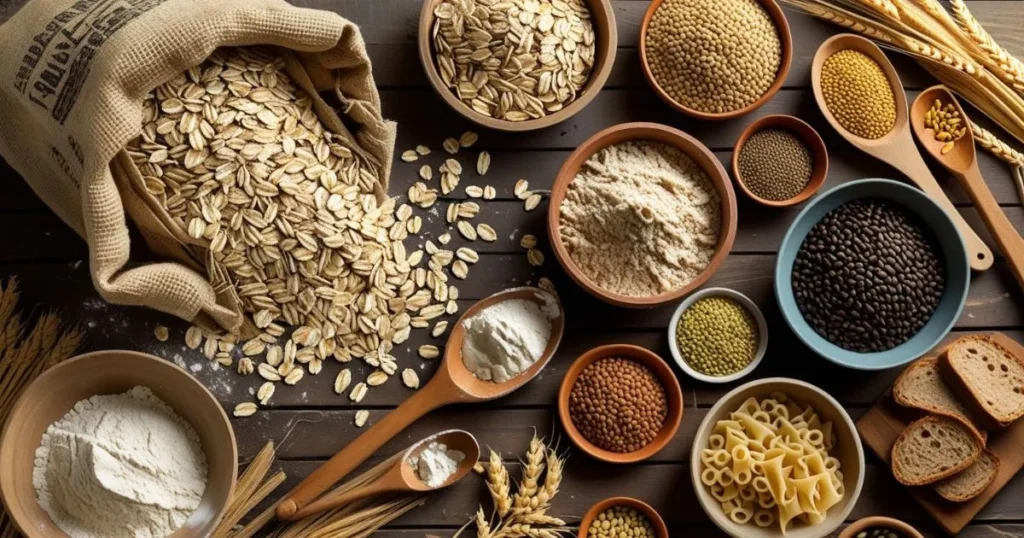How to Carb Cycle: 7-Day Smart Plan for Energy
Introduction – Why You’re Tired of “One-Size-Fits-All” Diets
The Diet Struggle You Know Too Well
You’re doing all the “right” things — cutting carbs, training hard, staying consistent — but the results just aren’t showing. Your energy is low, workouts feel harder than they should, and nothing on the scale seems to change. Sound familiar?
A Smarter, Flexible Alternative
That’s where learning how to carb cycle makes the difference. It’s a flexible strategy that aligns your food with your activity level, helping you burn fat while staying energized and strong. And the best part? It fits into your lifestyle—whether you’re following keto, low-carb, or just tired of restrictive dieting.
What You’ll Learn in This Guide
This step-by-step guide will walk you through how to carb cycle, why it works, and how to make it part of your daily routine — with real meal plans, practical tips, and sustainable results.
Table of Contents
How to Carb Cycle: What It Is and Why It Works
Definition and Core Concept
What is carb cycling? In simple terms, it’s a planned, strategic way of rotating your daily carbohydrate intake—cycling between high-carb, moderate-carb, and low-carb days—so your nutrition matches your training load, recovery needs, and fat-loss goals. Rather than using a fixed macro split every day, carb cycling lets you adjust your intake—going higher on intense days and lowering it when your body doesn’t need the extra fuel.
High-carb days restore muscle glycogen and boost your training output. On lighter or rest days, shift to moderate or low-carb intake to maintain stable energy and encourage your body to burn fat stores efficiently. This rhythmic approach allows you to capture the best of both worlds: the metabolic advantages of low-carb living and the athletic edge that adequate carbs provide.
Why It Works for Active Lifestyles
This approach is especially popular with athletes and fitness enthusiasts because it helps them overcome fat-loss barriers without needing to give up carb flexibility in their routine.
- High-carb days: Support intense training and rapid recovery
- Moderate-carb days: Maintain energy without excessive fat storage
- Low-carb days: Encourage fat burning and improved insulin control
High-Carb Days
When to Schedule Them
Plan your high-carb days to coincide with your most demanding training sessions—leg day, heavy compound lifts, HIIT, or endurance events. Scheduling carbs around peak effort ensures the glucose is used immediately for fuel and recovery instead of being stored as fat.
Best Food Choices
Choose slow-digesting carbs like sweet potatoes, oats, quinoa, or berries to restore energy without sharp glucose spikes. Pairing these with lean proteins helps stabilize digestion and supports muscle recovery.
Moderate-Carb Days
Ideal for Balanced Recovery
Moderate-carb days serve as a balanced middle ground—ideal for recovery sessions or light training—giving your body the carbs it needs to rebuild muscle without overshooting your calorie goals.
Macronutrient Goals
Aim for roughly 1 g of protein per pound of body weight, 100–150 g of carbohydrates, and enough healthy fats to meet your calorie budget. This balance supports glycogen maintenance and steady energy without encouraging fat storage.
Low-Carb Days
Boosting Fat Loss
Lowering your net carbs under 50 grams on low-carb days encourages your body to tap into stored fat for energy. This also helps improve how your body responds to insulin and can enhance fat loss — particularly when combined with gentle activity or rest days.
Meal Examples
- Breakfast: Nutrient-rich vegetable omelet cooked in heart-healthy olive oil, paired with creamy avocado for healthy fats.
- Lunch: Grilled salmon over spinach with walnut vinaigrette
- Dinner: Grass-fed steak with cauliflower mash and steamed asparagus
How Does Carb Cycling Work?
The Science Behind It
At its core, carb cycling is about managing your body’s fuel systems. Understanding how to carb cycle means learning to switch between high and low carb days in a way that triggers hormonal changes to boost metabolism and fat burning. On low-carb days, insulin levels stay low, promoting the use of stored fat as fuel. On high-carb days, your body releases key hormones like leptin and thyroid regulators that keep your metabolism active and prevent stalls.
Hormonal and Metabolic Impact
This smart manipulation of carbohydrates — once you know how to carb cycle properly — allows you to benefit from the fat-burning effects of a low-carb diet while still enjoying the energy and muscle-repair benefits of higher carb intake when needed. It reduces adaptation to a single calorie target and prevents your metabolism from slowing down. This flexibility also reduces mental fatigue associated with strict dieting and improves adherence in the long run.
Can It Help You Lose Weight?
Why Carb Cycling Works for Fat Loss
Absolutely. Carb cycling for weight loss is one of the most effective strategies for breaking through fat-loss plateaus and avoiding metabolic adaptation. By cycling between low- and high-carb days, you activate your metabolism, improve hormonal regulation, and enhance your body’s ability to burn fat for energy.
Metabolic Flexibility and Hormone Regulation
On low-carb days, lower insulin levels encourage your body to shift into fat-burning mode by accessing stored fat reserves. On high-carb days, hormones like leptin and thyroid get a boost, which can help prevent the slow-down commonly seen with long-term dieting. Once you understand how to carb cycle, you can better support your body’s natural fuel rhythms and avoid the metabolic slowdown often triggered by consistently low energy intake.
Long-Term Sustainability
A major benefit of learning how to carb cycle is its long-term sustainability. Instead of cutting out carbs completely, you’re using them in a way that fuels your training and supports fat loss — all while reducing cravings and diet fatigue. It’s ideal for those who need structure without sacrificing flexibility or lasting results.
How to Carb Cycle for Muscle Gain and Sports Performance
Why Timing and Carbs Matter
Knowing how to carb cycle for muscle gain revolves around nutrient timing and proper fueling. By placing high-carb days around your most intense training sessions, you give your muscles the glycogen they need for strength, endurance, and hypertrophy. This is critical for bodybuilders, athletes, and anyone engaging in high-frequency or high-volume training.

Post-Workout Recovery and Cortisol Control
The spike in insulin on high-carb days doesn’t just replenish glycogen—it also blunts cortisol, the stress hormone that breaks down muscle tissue. When you understand how to carb cycle correctly, you can reduce post-workout muscle breakdown and promote faster recovery, supporting lean muscle preservation and growth.
Lean Bulking vs Dirty Bulking
Unlike traditional bulking diets that often lead to fat gain, carb cycling allows for lean muscle gain without the added fluff. You’re eating more carbs on the days your body needs them—and scaling back when it doesn’t. This results in cleaner muscle growth, better body composition, and improved performance.
Other Benefits of Carb Cycling
Mental Clarity and Cognitive Performance
One often overlooked benefit of learning how to carb cycle is its impact on mental clarity. People who follow strict low-carb diets may experience brain fog or decreased focus over time. By cycling carbs back into your diet—especially on high-carb days—you support healthy brain function, neurotransmitter production, and overall cognitive performance.
Greater Dietary Flexibility
Understanding how to carb cycle gives you the freedom to enjoy high-carb meals during social events, family gatherings, or celebrations without feeling guilty or derailing your goals. This flexibility is a huge psychological relief and can help improve diet adherence, making your nutrition plan more sustainable in the long run.
Hormonal Balance and Women’s Health
For women in particular, knowing how to carb cycle for hormonal balance offers significant advantages. Reintroducing carbs regularly can help regulate leptin, ghrelin, and thyroid hormones, which are all impacted by prolonged low-carb or calorie-restrictive diets. It supports menstrual health, reduces mood swings, and maintains better hormonal function overall.
A Holistic Health Approach
At its core, how to carb cycle isn’t just about aesthetics or physique goals—it’s about building a resilient, healthy metabolism and body. Whether you want better energy, clearer thinking, or improved hormonal balance, carb cycling offers a dynamic strategy to help you thrive physically and mentally
How to Do Carb Cycling
How to Carb Cycle: Overview of the Strategy That Works
Learning how to carb cycle properly is key to reaping its fat-burning and muscle-building benefits. This strategy is based on alternating your carbohydrate intake to match your physical activity, allowing you to fuel your body when it needs energy and scale back when you’re resting.
A successful approach to how to carb cycle starts with choosing a weekly structure — including high-carb days for performance, low-carb days for fat loss and insulin control, and moderate-carb days for balance.
Next, calculate your macronutrient needs: determine your protein intake, adjust carbs based on training, and balance with healthy fats. Proper carb timing (pre- and post-workout) improves performance and glycogen replenishment.
To keep your results sustainable, plan meals with whole, nutrient-dense foods and track your progress weekly. By understanding the mechanics and aligning them with your schedule, you’ll fully master how to carb cycle for long-term success.
Step 1 – Choose Your Weekly Structure
A clear structure sets the foundation for success. Choose one of the following patterns based on your fitness goals:
- 3 High / 4 Low Days: Ideal for balanced fat loss and muscle recovery if you train most of the week.
- 2 High / 5 Low Days: Better for more aggressive cutting phases with limited high-carb intake.
- Alternating Days: Great for maintaining energy balance and supporting metabolic flexibility.
Step 2 – Set Your Macros
Use a macro calculator to determine your daily calorie and macronutrient needs based on your weight, training level, and goals.
- Adjusting Based on Cycle
- On high-carb days: Increase carbs and reduce fats.
- On low-carb days: Reduce carbs significantly, increase healthy fats, and keep protein stable.
Step 3 – Time Your Carbs Around Workouts
Carb timing can enhance athletic performance and recovery.
- Before Workouts: Eat slow-digesting carbs like oats or sweet potatoes 1–2 hours before to fuel training.
- After Workouts: Pair quickly absorbed carbs—such as white rice or fruit—with a lean protein source to refill energy stores and aid muscle repair post-workout.
Step 4 – Plan Your Meals
Smart meal planning ensures long-term success and adherence.
- High-Carb Day Example
- Breakfast: Oatmeal with berries and egg whites
- Lunch: Grilled chicken, steamed vegetables, and a serving of brown rice to keep your energy steady and your macros balanced.
- Dinner: Baked salmon with sweet potato and salad
- Low-Carb Day Example
- Breakfast: Scrambled eggs with spinach and avocado
- Lunch: Turkey lettuce wraps with olive oil dressing
- Evening meal: Try a grilled steak alongside creamy cauliflower purée and crisp asparagus for a low-carb, nutrient-rich option.
Recommended Carb Sources
Why Carb Quality Matters When Learning How to Carb Cycle
Choosing the right carbohydrates makes a huge difference in your performance, fat loss, and digestion. When you understand how to carb cycle effectively, focusing on whole, fiber-rich carbs becomes even more important. These slow-digesting carbs not only fuel your body but also help maintain stable glucose levels, reduce cravings, and support long-term health.
Best Complex Carb Sources for Carb Cycling
Prioritize complex carbs that digest slowly and are packed with fiber and nutrients—perfect choices for days when you need sustained energy and performance.
- Top Choices
- Quinoa: Both protein- and fiber-rich, offering long-lasting energy throughout the day.
- Steel-cut oats: Excellent for breakfast; slow-burning carbs.
- Sweet potatoes: Nutrient-dense and versatile.
- Brown rice: Gentle on digestion and helps restore muscle glycogen after training.
- Lentils and black beans: Packed with fiber and minerals that promote digestive health and overall nutritional balance.
- Butternut squash: A nutrient-dense food high in vitamins A and C, helping to strengthen immunity and support muscle recovery, especially on rest or low-carb days.
- Berries and whole fruits (in moderation): Add natural sweetness and antioxidants.
When to Use These Carbs
In your carb cycling meal plan, use these carb sources primarily on:
- High-carb days for energy and recovery
- Moderate-carb days for stable energy throughout the day
Avoid relying heavily on these during low-carb days, when the focus should shift toward protein and healthy fats. These smart carbohydrate choices not only enhance performance and fat burning, but also make your carb cycling plan sustainable and enjoyable.
Simple vs. Complex Carbohydrates

Understanding Carbohydrate Types
Understanding the difference between simple and complex carbohydrates is crucial when following a carb cycling plan. Each type of carbohydrate affects your metabolism, energy levels, and fat-burning potential differently. Learning to differentiate them helps you make smarter nutritional choices based on your goals.
What Are Simple Carbohydrates?
Definition and Sources
Simple carbohydrates digest quickly, often triggering sharp increases in both blood sugar and insulin shortly after consumption. Common sources include:
- Sugar
- White bread
- Pastries
- Soda
- Processed snacks
When (and When Not) to Use Them
Although simple carbs support fast glycogen recovery post-workout, excessive intake may lead to fatigue, heightened hunger, and fat storage. In a structured carb cycling diet, limit simple carbs to strategic moments such as immediately after intense exercise.
What Are Complex Carbohydrates?
Definition and Sources
Complex carbs digest slowly due to their long molecular structure, delivering a consistent energy flow rather than a quick spike. Examples include:
- Sweet potatoes
- Oats
- Legumes
- Brown rice
- Vegetables
Benefits in a Carb Cycling Plan
These foods provide:
- More sustained energy
- Better insulin control
- Higher fiber intake
- Improved digestive health
Ideal for high or moderate carb days, complex carbs help maintain steady energy levels while minimizing fat storage.
Smart Carb Choices for Each Day Type
- High-Carb Days
- Focus on complex carbs for sustained energy
- Include a small amount of simple carbs post-workout
- Low-Carb Days
- Limit both simple and complex carbs
- Focus on healthy fats and lean proteins
Strategically timing your carb intake with the appropriate carb types improves your meal plan’s efficiency, stabilizes energy, and supports ongoing fat loss goals and performance.
How to Eat Carbohydrates in a Healthful Way
Choose Nutrient-Dense Carbohydrates
To eat carbohydrates in a healthful way, focus on whole, unprocessed foods that are rich in nutrients and fiber. Examples include sweet potatoes, oats, brown rice, legumes, fruits, and non-starchy vegetables. These options digest slowly and provide steady energy, supporting both fat loss and performance goals in a carb cycling diet.
Combine Carbs with Protein and Healthy Fats
Why Pairing Matters
When you eat carbs with protein and fats, it slows down digestion, reduces glucose spikes, and increases satiety. Supporting appetite control, reducing cravings, and stabilizing blood glucose are key benefits of this method. For example:
- Oats + almond butter
- Sweet potatoes + grilled chicken
Benefits for Carb Cycling
Pairing your carbs properly makes your meals more effective for recovery and energy while minimizing fat storage. A powerful tool, this approach works best on high and moderate carb days to support energy and performance.
Avoid Processed and Refined Carbs
Eliminate or minimize sources like sugary snacks, white bread, and soda. These provide quick energy but lead to blood sugar crashes, increased hunger, and poor metabolic health. Stick with whole food sources for long-term results.
A healthful approach to carbs isn’t about elimination—it’s about strategic use. In the context of a carb cycling lifestyle, learning how to eat carbs the right way will help you maximize fat loss, maintain energy, and build a more sustainable, enjoyable eating pattern.
What Carbs Should You Avoid?
Understanding Harmful Carbs
Identifying the wrong types of carbs is equally vital as choosing the right ones to make your carb cycling plan truly effective. Certain types of carbohydrates can undermine your progress toward fat loss, metabolic health, and improved performance.
Refined and Processed Carbohydrates
Common Examples
Refining carbohydrates removes essential nutrients and fiber, significantly decreasing their health benefits and nutritional impact. These include:
- White bread
- Sugary cereals
- Pastries
- Candy
- Soda
- Ultra-processed snacks
Impact on Health
These high-glycemic foods cause rapid insulin spikes and blood sugar crashes, which can:
- Increase fat storage
- Trigger cravings and mood swings
- Reduce overall energy levels
- Contribute to inflammation
Carb Timing and Exceptions
Strategic Use After Workouts
While these carbs are generally discouraged, there is one exception—post-workout nutrition. After intense training, your body is more insulin-sensitive and may benefit from a limited intake of fast-digesting carbs to replenish muscle glycogen.
What to Focus on Instead
For optimal results throughout your day and week, give priority to:
- Whole, nutrient-dense carbs
- Slow-digesting, fiber-rich options
- Balanced meals that support blood sugar stability
By limiting refined carbohydrates and focusing on quality sources, you’ll create a more effective and sustainable carb cycling diet that supports both short-term goals and long-term health.
7 Tips for Reaching Ketosis Faster (Optional for Keto-Based Carb Cycling)

Why Getting Back into Ketosis Matters
If you’re combining a carb cycling plan with a ketogenic diet, transitioning back into ketosis after a high-carb day can be a challenge — but it’s entirely manageable with the right approach. Achieving ketosis promotes fat metabolism, boosts cognitive clarity, and helps stabilize insulin levels. These ketosis tips are designed to help you reset your metabolic state quickly and effectively.
What Happens After a High-Carb Day?
After a refeed or high-carb intake, your body uses up glycogen stores and experiences a temporary increase in insulin and blood sugar. The goal of these tips is to:
- Deplete glycogen
- Lower insulin levels
- Shift metabolism back into ketone production
7 Proven Tips to Reach Ketosis Faster
- Reduce Carbohydrate Intake Immediately: Lower your net carb intake to 20–30g the day after a high-carb day to quickly reduce blood glucose and promote ketone production.
- Increase Physical Activity: Engage in fasted cardio or strength training to burn through remaining glycogen stores and signal your body to switch to fat as its primary fuel source.
- Use Intermittent Fasting: A 14–18 hour intermittent fast following a refeed can enhance fat oxidation and fast-track your body’s reentry into ketosis.
- Raise Healthy Fat Intake: Increase intake of healthy fats (avocados, olive oil, nuts) to support ketone production and balance energy levels.
- Test Ketone Levels: Monitoring your ketone levels with test strips or a blood meter helps you evaluate progress and ensure your carb cycling plan is working effectively.
- Moderate Protein Intake: Consuming large amounts of protein can trigger gluconeogenesis, a metabolic process that converts protein into glucose. Stick to moderate amounts to stay in ketosis.
- Prioritize Sleep and Stress Reduction: Lack of sleep and high stress raise cortisol, which can interfere with insulin sensitivity and ketone generation. Prioritizing restorative sleep and incorporating stress-reducing techniques such as meditation and mindfulness can significantly enhance overall well-being and fat loss results.
Putting It All Together
Using these techniques allows your body to efficiently shift back into nutritional ketosis after a high-carb intake, supporting ongoing fat-burning and metabolic balance. Properly managing your macronutrients, exercise, and lifestyle helps you sustain the key benefits of carb cycling and keto—like fat loss, mental clarity, and metabolic adaptability.
Example Meal Plans
See the full 7-day plan below with calorie, macro, and dinner examples:
| Day | Carb Type | Calories | Protein | Carbs | Fat | Dinner Example |
| Monday | High | 2,000 | 160g | 200g | 55g | Chicken teriyaki + rice |
| Tuesday | Low | 1,600 | 150g | 40g | 90g | Beef stir-fry + broccoli |
| Wednesday | Moderate | 1,800 | 155g | 100g | 70g | Ground turkey + quinoa bowl |
| Thursday | High | 2,200 | 170g | 220g | 60g | Grilled salmon + roasted potatoes |
| Friday | Low | 1,500 | 145g | 30g | 95g | Keto shrimp Alfredo |
| Saturday | High | 2,100 | 175g | 210g | 58g | Pasta + meatballs (gluten-free) |
| Sunday | Low | 1,500 | 140g | 25g | 95g | Roasted chicken + spinach salad |
Want the full 7-day plan in PDF? Get your meal guide + grocery list here.
Takeaways
Why Carb Cycling Is Worth It
Carb cycling takeaways highlight the practical power of this flexible dietary strategy. Whether your goal is fat loss, muscle gain, or sustained energy levels, a well-structured plan based on learning how to carb cycle aligns your nutrition with your physical demands. This method allows you to benefit from high-carb days that fuel performance and low-carb days that promote fat burning and insulin sensitivity.
Flexibility Over Restriction
Unlike rigid diets, understanding how to carb cycle empowers you to adjust your carbohydrate intake based on your schedule and goals. This adaptability improves dietary adherence and makes long-term success more achievable. You don’t have to eliminate carbs — you just learn how to use them strategically.
Key Strategies to Remember
- Match Carbs to Activity: Aligning your carb intake with your exercise intensity—higher on active days, lower on rest days—can enhance performance and fat loss.
- Prioritize Whole Foods: Use nutrient-dense foods to balance blood sugar and improve gut health and recovery.
- Track and Adapt: Monitor your progress, energy, and body composition to fine-tune your macro targets and carb cycle structure.
Final Words of Advice
Success with carb cycling isn’t about being perfect—it’s about being consistent and responsive to your body’s feedback. Through strategic planning and high-quality nutrition, carb cycling enables you to improve performance, build your ideal physique, and maintain long-term metabolic health and lifestyle sustainability.
Start simple. Test what works. Stay consistent.
Carb Timing Tips for Better Results
Mastering how to carb cycle isn’t just about selecting high-carb or low-carb days — it’s also about timing your intake to match your body’s energy needs throughout the day.

Carb timing is a powerful but often overlooked strategy that aligns your intake with your body’s natural energy demands. Whether you’re aiming to lose fat, boost energy, or improve workout performance, eating the right type of carbs at the right time can elevate your results.
– Before Intense Workouts
Include moderate to high-carb meals 1–2 hours before training to fuel your body and maximize performance.
– After Training
Prioritize carbohydrates post-workout to replenish glycogen stores and support muscle recovery.
– On Rest or Low-Activity Days
Lowering your carb intake on non-training days helps activate fat-burning pathways and supports better insulin sensitivity.
By combining strategic carb timing with your weekly plan, you’re not just learning how to carb cycle — you’re optimizing it.
Who Should Not Follow a Carb Cycling Diet?
Carb cycling isn’t suitable for everyone. You should avoid this approach if you:
- Are pregnant or breastfeeding
- Have a history of eating disorders
- Are managing diabetes, thyroid issues, or adrenal imbalances without medical supervision
- Are currently taking medication that affects blood sugar, hormones, or metabolism
Always consult a healthcare provider or registered dietitian before starting carb cycling to ensure it’s safe and appropriate for your personal health condition.
FAQ – How to Carb Cycle
Q1: What’s the best way to combine carb cycling with keto?
A: If you’re wondering how to carb cycle while staying keto, limit high-carb days to no more than 100g net carbs. Time them around your workouts to fuel performance and recovery, while maintaining a ketogenic state on the other days.
Q2: How long does it take for carb cycling to show effects?
A: Many people start feeling results from learning how to carb cycle in the first week — including more energy, better performance, and reduced cravings. Visible fat loss usually appears within a few consistent weeks.
Q3: Can women carb cycle during their cycle?
A: Absolutely. Understanding how to carb cycle around your menstrual cycle can improve energy, stabilize mood, and support hormonal balance — especially during the luteal phase.
Q4: Do I have to count every macro?
A: When you’re first learning how to carb cycle, tracking macros helps ensure you’re hitting your targets. After a few weeks, you may be able to follow it more intuitively based on your results and experience.
Q5: Is carb cycling safe long-term?
A: Yes — especially when you understand how to carb cycle properly. It’s often more sustainable than rigid low-carb diets and supports long-term fat loss and energy management.
💬 Want more tips and tools? Join the Newsletter or Check Out Our Free Carb Cycling Calculator
Conclusion
Understanding how to carb cycle can transform the way you fuel your body—without the extremes of traditional diets. By aligning your carb intake with your physical activity, you support fat loss, muscle performance, and long-term energy. The beauty of carb cycling is in its flexibility: you don’t have to give up carbs—you just learn to use them smartly.
Start simple, test what works for your body, and stay consistent. Whether your goal is to burn fat, boost performance, or improve metabolic health, learning how to carb cycle gives you the tools to get there.

